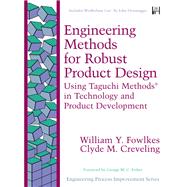William Y. Fowlkes, winner of the prestigious Taguchi Award for his work at Eastman Kodak, is experienced both in using Taguchi methods as well as teaching them. He teaches a course on robust design at the Rochester Institute of Technology, has created a video tape and tele-course on the subject that is used at General Motors, and was instrumental in creating the training materials on robust design that continue to be used at Eastman Kodak.
Clyde "Skip" Creveling is the president and founder of Product Development Systems & Solutions Inc. (PDSS) (http://www.pdssinc.com). Since PDSS' founding in 2002, Mr. Creveling has led Design for Six Sigma (DFSS) initiatives at Motorola, Carrier Corporation, StorageTek, Cummins Engine, BD, Mine Safety Appliances, Callaway Golf, and a major pharmaceutical company. Prior to founding PDSS, Mr. Creveling was an independent consultant, DFSS Product Manager, and DFSS Project Manager with Sigma Breakthrough Technologies Inc. (SBTI). During his tenure at SBTI he served as the DFSS Project Manager for 3M, Samsung SDI, Sequa Corp., and Universal Instruments.
Mr. Creveling was employed by Eastman Kodak for 17 years as a product development engineer within the Office Imaging Division. He also spent 18 months as a systems engineer for Heidelberg Digital as a member of the System Engineering Group. During his career at Kodak and Heidelberg he worked in R&D, Product Development/Design/System Engineering, and Manufacturing. Mr. Creveling has five U.S. patents.
He was an assistant professor at Rochester Institute of Technology for four years, developing and teaching undergraduate and graduate courses in mechanical engineering design, product and production system development, concept design, robust design, and tolerance design. Mr. Creveling is also a certified expert in Taguchi Methods.
He has lectured, conducted training, and consulted on product development process improvement, design for Six Sigma methods, technology development for Six Sigma, critical parameter management, robust design, and tolerance design theory and applications in numerous U.S, European, and Asian locations. He has been a guest lecturer at MIT, where he assisted in the development of a graduate course in robust design for the System Design and Management program.
Mr. Creveling is the author or coauthor of several books, including Six Sigma for Technical Processes, Six Sigma for Marketing Processes, Design for Six Sigma in Technology and Product Development, Tolerance Design, and Engineering Methods for Robust Product Design. He is the editorial advisor for Prentice Hall's Six Sigma for Innovation and Growth Series.
Mr. Creveling holds a B.S. in mechanical engineering technology and an M.S. from Rochester Institute of Technology.








